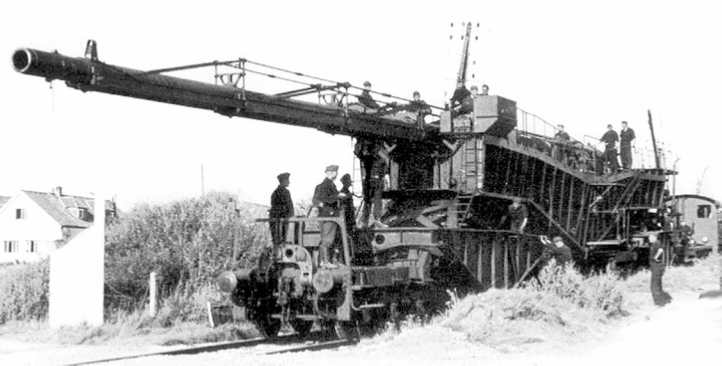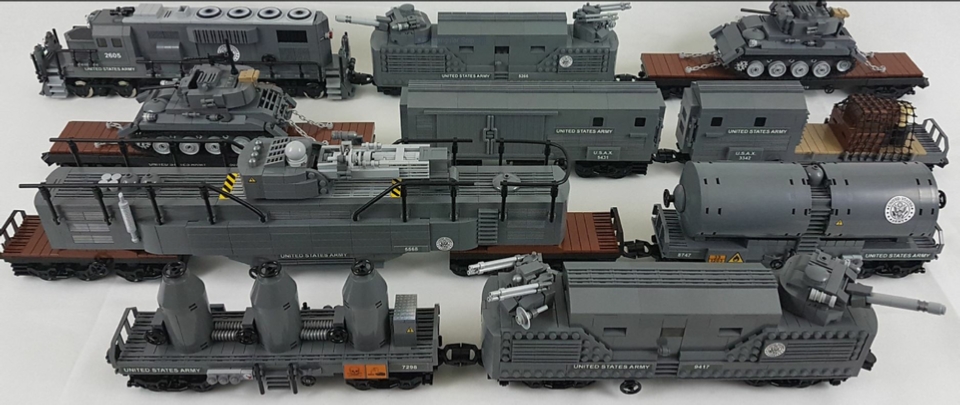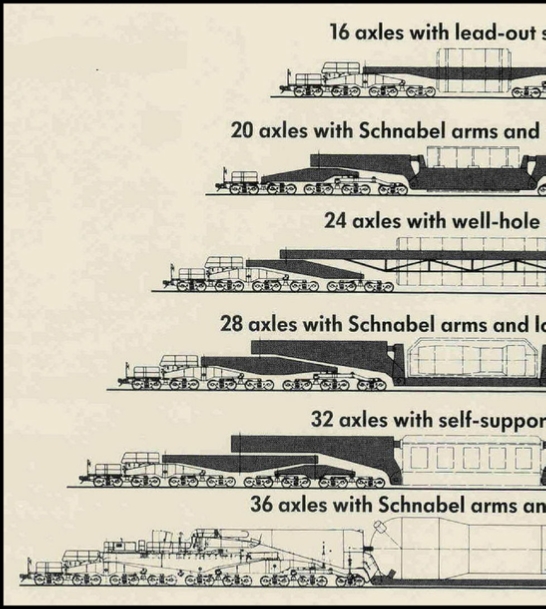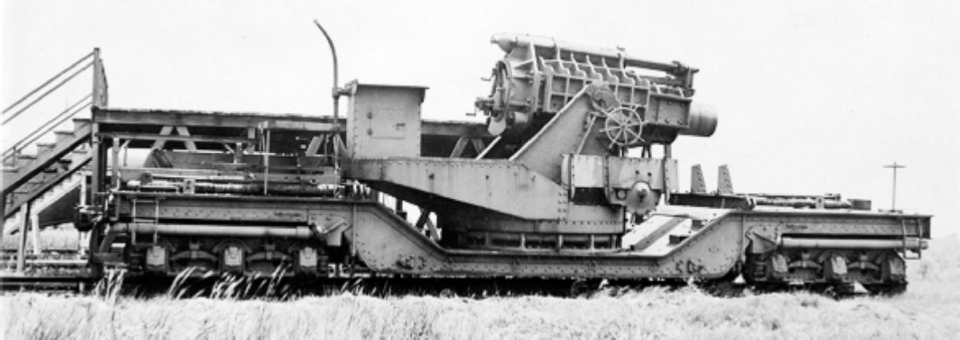

Railroad Mounted Artillery Types
Throughout history, the effectiveness of artillery on the battlefield has often dictated the outcomes of significant conflicts. Three main categories of artillery—guns (cannon), howitzers, and mortars—have consistently been used, each with distinct characteristics and specialized tactical roles. While collectively referred to as "artillery," their differences in design, purpose, mobility, firing angle, and projectile type reveal nuanced tactical versatility. Understanding these differences provides valuable insight into their historical evolution and battlefield significance.
Railroad-Mounted Guns or Cannon
Railroad-mounted artillery classified as guns or cannons traditionally refers to very long-barreled, high-velocity, direct-fire weapons placed upon specially engineered railway carriages. These formidable weapons were primarily designed to strike heavily fortified positions, hardened bunkers, critical bridges, enemy artillery positions, and strategic targets at considerable distances. Due to their extraordinarily long barrels and massive size, railroad guns delivered projectiles at higher velocities along relatively flat trajectories, which enhanced accuracy and destructive power at extended ranges. Railroad-mounted guns excelled in direct-fire roles, where operators possessed direct or near-direct lines of sight to distant targets.
Historically, railroad guns appeared prominently in the late 19th and early 20th centuries, reaching their peak development and usage during World Wars I and II. Unlike earlier artillery that required teams of horses or large numbers of soldiers to reposition heavy cannons across battlefield terrain, railroad-mounted artillery utilized existing railway infrastructure. These railway guns could be efficiently moved along rail lines, repositioned quickly for strategic targeting, and redeployed to safer locations after firing, making them a uniquely mobile form of heavy artillery. The massive scale and weight of railroad guns allowed them to fire heavier projectiles—often weighing hundreds or even thousands of pounds—far surpassing conventional artillery pieces.
On battlefields throughout World War I, railway-mounted cannons gained prominence through their ability to deliver concentrated bombardments against strategic fortifications and logistical centers behind enemy lines. Famous railway guns of the time, such as the German rail-mounted version of the "Paris Gun," demonstrated the staggering capabilities of railroad artillery by firing projectiles over distances exceeding 70 miles (112 km). During World War II, these railroad-mounted cannons reached even greater proportions and destructive potential. Examples include Germany's infamous "Schwerer Gustav," an immense 800mm railway gun capable of destroying heavily reinforced fortifications and bunkers considered impenetrable by conventional artillery or aerial bombardment.
RailroadGuns.com
Welcome to RailroadGuns.com: Your Comprehensive Source on Military Railroads, Locomotives, Guns, and Rolling Stock Worldwide
RailroadGuns.com is dedicated to the fascinating and historically rich intersection of railroads and military operations throughout the world. While our name highlights the powerful railroad-mounted artillery known as railway guns, our scope extends far beyond this, encompassing all aspects of military railroads, locomotives, and specialized rolling stock used across global conflicts and interventions. From the massive armored trains of World War II to the strategic rail movements of modern militaries, RailroadGuns.com aims to provide an in-depth exploration of this crucial yet often overlooked element of warfare.
Throughout history, military railroads have been decisive in shaping battlefields, influencing campaigns, and determining the outcomes of wars. Railways allowed for the rapid deployment of troops, heavy artillery, tanks, and critical supplies, changing the scale and speed of military logistics. Railroad locomotives, adapted specifically for wartime needs, often operated under extreme conditions, from harsh Siberian winters to scorching North African deserts, demonstrating extraordinary reliability and versatility. Our website delves into these fascinating stories, tracing the evolution of military rail transport from the early use of railways during the American Civil War to their pivotal roles in both World Wars and beyond.
A central focus of RailroadGuns.com is the iconic railway artillery—massive guns mounted on railway carriages capable of bombarding targets from great distances with extraordinary accuracy and destructive force. These railway guns, such as the rail-mounted army version of the legendary navy fixed-mount "Paris Gun" of World War I or Germany’s massive 800mm Schwerer Gustav" of World War II, illustrate engineering ingenuity and military ambition. We present detailed histories, specifications, technical descriptions, and firsthand accounts of these formidable weapons in action.
Yet, railway guns represent only part of our broader examination. RailroadGuns.com also extensively covers specialized rolling stock designed explicitly for military use. This includes armored trains, trains used for infantry support, armored cars with machine guns and artillery platforms, troop trains for rapid mobilization, hospital trains for battlefield evacuation, narrow gauge railroading, and boxcars, flatcars or gondola cars customized to carry tanks and armored vehicles and other equipment to the front lines. Our comprehensive website highlights the technical details, photographs, historical context, and operational roles of these specialized rail vehicles.
Beyond weaponry and equipment, we also emphasize the remarkable stories of the men and women who built, maintained, and operated military railroads under extraordinary circumstances. Their contributions often remain hidden behind battlefield exploits but are fundamental to understanding modern warfare's logistical foundations.
RailroadGuns.com is built only for myself to gather information,
but invites enthusiasts, historians, modelers, and military scholars alike to explore this unique aspect of military history. We provide thoroughly researched articles, rare archival imagery, original diagrams, and detailed analyses covering every significant military railroad operation across all nations and time periods. Our mission is to foster greater understanding and appreciation for the critical role railways have played—and continue to play—in military strategy worldwide.
Join us in uncovering the fascinating world of military railroads, where history rides the rails, and discover how these steel wheels shaped wars and changed the course of global events.

Image: World War I German 21 cm K12 (E) - Kanone in Eisenbahnlafette 'Paris Gun'.. Only two of the rail-mounted versions were built.

A LEGO WWII Army supply train. Its builder Tablizm, brings us an amazing demo model of a US Army military train, showing off a variety of cars from different eras.

Krupp Schnabel Modular
Platform Types
Most heavy railroad guns use some type of Schnabel load mounting systems (See ‘Cradle Mounting Platforms’ Right). They held many replacement advantages similar to the modern Krupp Schnabel cars are of modular design. By changing individual assemblies and using additional or variations of support elements, the railroad guns could use the same parts while allowing them to be adapted in an optimum manner to varying transport requirements. This versatility also extends to the number of axles. As shown in the example of a 36-axle car (See Example Below).
Guns or Cannon Could: Batter heavy construction with solid shot at long or Short range; destroy fort parapets and, by ricochet fire, dismount cannon, shoot grape, canister, or bombs against massed personnel.
Howitzers Could: Move more easily in the field than mortars; reach targets behind obstructions by high angle fire; shoot larger projectiles than could field guns or cannon of similar weight.
Mortars Could: Reach targets behind obstructions; use high angle fire to shoot bombs, destroying construction and personnel.

Shell Trajectory Patterns
Railroad-Mounted Howitzers
Railroad-mounted howitzers represented a highly versatile intermediate artillery platform, combining features of cannon and mortars with the advantages provided by railway mobility. Unlike traditional railroad guns, railway howitzers had shorter barrels and lower muzzle velocities, allowing them to fire large explosive shells at higher angles to strike targets behind terrain features or fortifications.
First emerging prominently during World War I, railroad howitzers became essential in trench warfare, enabling heavy artillery support from safer, rearward positions. These railway howitzers could be rapidly repositioned along rail lines, responding quickly to changing tactical situations.
Their shells often featured larger explosive charges relative to projectile weight, enabling substantial destructive effects against trenches, bunkers, artillery batteries, and defensive positions.
Rail-mounted howitzers typically employed steep trajectories, firing shells at angles greater than conventional cannon but lower than mortars. This high-angle capability meant that railway howitzers could effectively strike targets hidden behind natural terrain or artificial obstructions such as hills, buildings, or walls. As rail infrastructure expanded during warfare, railway howitzers were frequently positioned near the front lines, rapidly delivering heavy artillery fire, then quickly relocating before enemy counter-battery strikes.
Railway howitzers played significant roles in battles during both world wars. Allied railway artillery units in World War I used them extensively to bombard entrenched German positions along the Western Front, while United States railway howitzers, such as the 12-inch M1918 Railway Howitzer, was introduced late in World War I to enhance American artillery capability on the Western Front by bombarding enemy positions from behind fortifications. The howitzer design combined heavy firepower with a railway carriage, enabling rapid strategic redeployment along railroad networks. Their balance of power, trajectory versatility, and rail mobility contributed significantly to artillery doctrines of the era.

United States WWI 12-inch 20 Caliber M1918 railway mount howitzer built for coastal defense.
|
Feature
|
Railway Gun
(German Krupp K5e)
|
Railway Howitzer
(U.S. 12-inch M1918)
|
Railway Mortar
(U.S. 12-inch M1890)
|
|
Barrel
Length
|
Very long barrel
|
Medium-length barrel
|
Very short barrel
|
|
Muzzle
Velocity
|
High muzzle velocity
|
Moderate muzzle velocity
|
Relatively low muzzle velocity
|
|
Trajectory
|
Flat, direct-fire trajectory
|
Moderate to high-angle indirect trajectory
|
Extremely high-angle, steep indirect trajectory
|
|
Range
|
Very long range
|
Intermediate range
|
Relatively shorter range
|
|
Mobility
|
Limited; requires robust track infrastructure
|
More flexible; moderate track requirements
|
Limited; specialized reinforced railway platforms
|
|
Shell
Types
|
Solid shot, armor-piercing (AP), high explosive (HE), occasionally anti-personnel
|
Primarily high-explosive (HE) shells
|
Large, heavy explosive shells (“bombs”)
|
|
Target
Types
|
Fortifications, bunkers, strategic infrastructure at long distances, enemy artillery
|
Fortifications, entrenched positions, troops behind cover, artillery positions
|
Deeply entrenched fortifications, heavily protected targets, enemy trenches, concealed positions
|
Distinguishing Features (Railway Gun vs. Railway Howitzer vs. Railway Mortar)
This table clearly illustrates the significant tactical and technical differences between railway-mounted guns, howitzers, and mortars, reflecting their unique roles and deployment strategies on the battlefield.
Railroad-Mounted Mortars
Railroad-mounted mortars were specialized artillery pieces defined by their extremely short barrels and exceptionally steep, high-angle trajectories. Mounted on reinforced rail carriages, these mortars launched massive explosive bombs capable of attacking fortified targets otherwise impervious to direct-fire artillery. Their steep trajectories allowed mortar shells to fall vertically onto enemy positions, penetrating roofs, bunkers, ammunition magazines, and deeply entrenched fortifications.
Railroad mortars trace their origin to late 19th-century coastal artillery and siege warfare. By World War I, railroad mortars reached impressive scales, exemplified by the American 12-inch railway mortars. These mortars fired shells high into the air, descending vertically to bypass heavy fortifications and strike internal targets. Mortar bombs typically carried enormous explosive charges, significantly greater in proportion to their caliber than cannon or howitzer projectiles, creating massive craters and devastating underground bunkers and fortifications.
A major operational advantage of railroad mortars was their ability to destroy entrenched enemy positions without requiring line-of-sight. This indirect-fire capability made them invaluable during sieges and positional warfare, enabling attacks on heavily fortified cities, bunkers, and trenches. Railroad mortars also proved highly effective in destroying reinforced enemy artillery positions, command posts, and communication centers located behind fortifications or hills.
Despite their destructive potential, railroad mortars faced practical challenges due to their immense recoil, limited range compared to other railway artillery, and logistical complexity. They required sturdy, specially reinforced rail platforms and careful alignment of rails before firing. Nevertheless, their unique ability to deliver high-angle, indirect fire made railroad mortars formidable siege weapons, substantially influencing the tactics of prolonged battles such as Verdun and other major engagements during World War I.

United States WWI era 12-inch M1890 Mortar on M1918 Railway Carriage could hurl a shell more than 10 miles and be put into operation in 15 minutes.
Railroad guns utilized various ammunition types depending on their intended mission. Primarily, they fired solid, armor-piercing shells or heavy high-explosive rounds to penetrate reinforced concrete bunkers, destroy strategic infrastructure such as bridges, rail yards, ammunition depots, and command centers. In specific scenarios, railroad guns employed direct ricochet fire, using heavy projectiles fired at shallow angles designed to bounce along the ground, demolishing fortification walls, disabling enemy artillery pieces, or disrupting massed infantry formations. Although less common than their siege applications, railroad cannons sometimes used specialized anti-personnel ammunition, such as large-caliber explosive shells designed to disperse fragmentation widely against infantry positions or supply convoys.
Railroad guns' destructive potential required sophisticated logistical support and infrastructure. Specialized railway carriages were designed to handle the immense recoil generated by these cannons, incorporating hydraulic or mechanical recoil absorption systems and robust chassis frames to maintain firing accuracy and prevent derailment. Their reliance on existing railway networks imposed operational limitations, requiring extensive planning to ensure railroad tracks and bridges could support the enormous weight. Consequently, railway-mounted cannons often required dedicated rail lines, reinforced track sections, or specially constructed firing spurs to position and operate effectively.
Significant technological innovations during the late 19th and early 20th centuries dramatically increased railroad-mounted artillery effectiveness. Improvements included breech-loading designs, enabling faster reloading and increased rates of fire; rifled barrels, enhancing accuracy and range; and advances in metallurgy and projectile technology, permitting the firing of heavier, more destructive shells with precision. This technological evolution enabled railroad guns to deliver massive destructive power to targets previously out of range or considered invulnerable.
Railway-mounted cannons provided strategic-level artillery capabilities, fulfilling unique tactical roles beyond conventional battlefield engagements. Their extraordinary range and destructive power allowed armies to engage and neutralize critical enemy resources, including factories, transportation networks, harbors, fortified coastal defenses, and strategic command and control centers located deep behind enemy lines. Additionally, railway guns could disrupt enemy logistics, cripple industrial output, and degrade morale by bombarding civilian infrastructure far beyond traditional artillery range, significantly influencing warfare during both world wars.
In summary, railroad-mounted guns or cannons combined unprecedented destructive power, accuracy, and strategic reach with the mobility afforded by railway infrastructure. Their ability to deliver precision bombardments from great distances shaped warfare during the late 19th and early-to-mid-20th centuries. Although eventually replaced by aircraft and ballistic missiles, railroad cannons represent a pivotal innovation in artillery development, exemplifying the extraordinary engineering efforts aimed at maximizing the effectiveness and strategic impact of artillery on the battlefield.

German 80 cm K (E) railway gun (Dora, Schwerer Gustav)
Under the Whyte notation for the classification of steam locomotives, the wheel arrangement of leading wheel axles or trucks are noted first, then the number of powered and coupled driving wheels their axles, and finally the trailing wheels on their axles or trucks. Thus, for example, 2-8-2 represents the wheel arrangement of two leading wheels on one axle or a leading truck, eight powered and coupled driving wheels on four axles, and two trailing wheels on one axle or trailing truck. This particular configuration of steam locomotive is most often referred to as a Mikado.
Locomotive Wheel Arraignments










